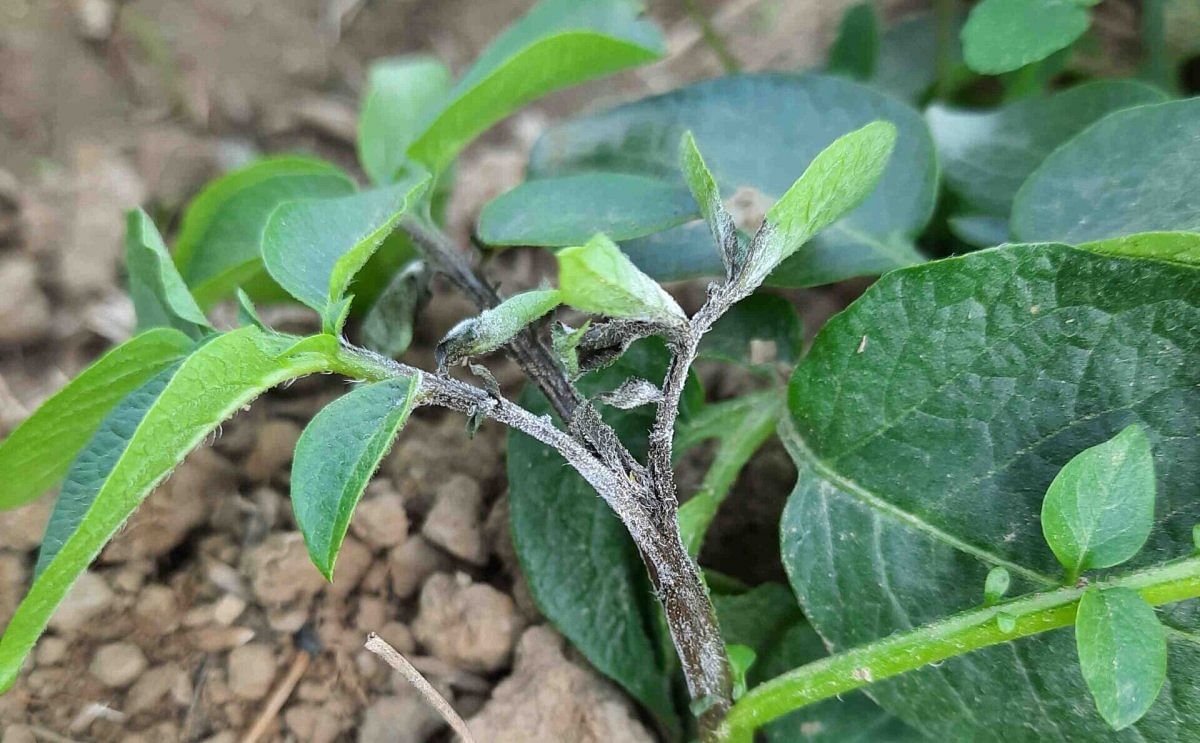Plant leaves showing blight infection
Blight studies reveal evolution of potato disease in Europe and Asia

Plant scientists at the James Hutton Institute are studying the evolution of late blight in potato by working with industry and research partners to track the distribution and diversity of dominant clones in Europe in 2020, and have also contributed to a review into the development of the disease in Asia in the last 150 years, as part of global efforts to improve the sustainable production of healthy potato crops.
Late blight played a major role in the historical Irish potato famine, and is still a huge problem for farmers today, causing massive crop losses and proving difficult to manage by chemical control and traditional breeding methods.
The EuroBlight consortium, which includes Aarhus University, Wageningen University, and INRAE, has tracked the European spatial distribution of Phytophthora infestans since 2013, and has added new data that visualises the distribution and diversity of dominant clones in the 2020 crop.
The report, which is available on the research group website, collates information from 1221 samples collected in 28 countries and genotyped in 2020.
As in previous years, 'FTA cards' were distributed to disease 'scouts' from across the industry who visited blight-infected crops.
Disease lesions were pressed on the cards and returned to the laboratories where the pathogen DNA was fingerprinted at the James Hutton Institute and INRAE, Rennes.
The DNA fingerprint data was used to define the clonal lineages of the pathogen and combined with geolocation data to plot the diversity across Europe.
James Hutton Institute researcher Dr. David Cooke, co-leader of the EuroBlight:
AsiaBlight is bringing together researchers from across the continent, promoting co-operation and data sharing with the goal of improving the sustainable production of healthy potato crops.
As part of this scientific effort, Dr. David Cooke is supporting the pathogen genotyping work and has contributed to a review, along with colleagues at West Bengal State University and Queen's University Belfast, into the development of potato late blight in Asia from 1870 to 2020.
The work shows clear evidence of the spread to Asia of several clonal lineages of P. infestans from Europe and, to a lesser extent, North America.
The review, titled Potato late blight in Asia: Phytophthora infestans over a century and a half – a Plant Pathology highlight, was published in the 15th March 2021 issue of Plant Pathology, a journal published by the British Society for Plant Pathology.
Late blight played a major role in the historical Irish potato famine, and is still a huge problem for farmers today, causing massive crop losses and proving difficult to manage by chemical control and traditional breeding methods.
The EuroBlight consortium, which includes Aarhus University, Wageningen University, and INRAE, has tracked the European spatial distribution of Phytophthora infestans since 2013, and has added new data that visualises the distribution and diversity of dominant clones in the 2020 crop.
The report, which is available on the research group website, collates information from 1221 samples collected in 28 countries and genotyped in 2020.
As in previous years, 'FTA cards' were distributed to disease 'scouts' from across the industry who visited blight-infected crops.
Disease lesions were pressed on the cards and returned to the laboratories where the pathogen DNA was fingerprinted at the James Hutton Institute and INRAE, Rennes.
The DNA fingerprint data was used to define the clonal lineages of the pathogen and combined with geolocation data to plot the diversity across Europe.
James Hutton Institute researcher Dr. David Cooke, co-leader of the EuroBlight:
“The blight pressure in 2020 was lower than average with a prolonged spell of warm, dry weather early in the season which checked the development of the disease in many regions.”Dr. David Cooke:
“The proportions of the main clones in the 2020 population structure were broadly similar to those reported in 2019. Three clones that first appeared in 2013 (EU_41_A2), 2014 (EU_37_A2, EU_36_A2), and EU_43, named in 2020, made up 40% of the 2020 population.”
“The survival and spread of these newer clones, when others are decreasing or have failed to establish, suggests they are evolutionarily fit and supports anecdotal evidence that they are more challenging to manage in the field.”The example of Euroblight as an international scientific network created to fight late blight is now being followed with a new network in Asia.
“Data has been passed to key partners across Europe to support integrated pest management approaches to blight control.”
AsiaBlight is bringing together researchers from across the continent, promoting co-operation and data sharing with the goal of improving the sustainable production of healthy potato crops.
As part of this scientific effort, Dr. David Cooke is supporting the pathogen genotyping work and has contributed to a review, along with colleagues at West Bengal State University and Queen's University Belfast, into the development of potato late blight in Asia from 1870 to 2020.
The work shows clear evidence of the spread to Asia of several clonal lineages of P. infestans from Europe and, to a lesser extent, North America.
The review, titled Potato late blight in Asia: Phytophthora infestans over a century and a half – a Plant Pathology highlight, was published in the 15th March 2021 issue of Plant Pathology, a journal published by the British Society for Plant Pathology.
Related documents
Results of the EuroBlight potato late blight monitoring in 2020 (free access)Potato late blight in Asia: Phytophthora infestans over a century and a half – a Plant Pathology highlight was published in the 15th March 2021 issue of Plant Pathology, a journal published by the British Society for Plant Pathology (for full access, a subscription is required)
Like to receive news like this by email? Join and Subscribe!
Get the latest potato industry news straight to your WhatsApp. Join the PotatoPro WhatsApp Community!
Uitgelichte Bedrijven
Sponsored Content
Sponsored Content
Sponsored Content
Sponsored Content








